
Glidden World Auto Tour
Fall 1904- Fall 1906
Charles Jasper Glidden
- aka “Colonel Glidden”
- b- Aug 29, 1857, in Lowell, Massachusetts, USA
- d- Sept 11, 1927, of Cancer, in Boston, USA, age 70
- Sick for over a month, died in his home
- Father- Nathaniel Glidden
- Mother Laura, nee Clark
- At one time he was a Director of Bell Telephone Company, He personally invented the Telephone Exchange for Bell, His brother, J. Clark Glidden was the First Telephone Operator.
- Wealthy Boston Banker.
- Started his career in 1873 as Manager of the Atlantic Pacific Telegraph Co.
- In 1876 he inaugurated Telephone Experiments with Alexander Graham Bell between Boston and Manchester NH
- He built private lines in Massachusetts and New Hampshire, and in 1877 procured the first subscriber in the world to a telephone exchange. This all happened in Lowell MA, his birthplace.
- He organized the Aerial Transportation Co. the first of its kind, to operate a line of airships between New York and Boston.
- He was a member of the Royal Geographic Society of London, and the Aero Clubs of France, England and the United States.
- He was also a member of the Masons.
Now what does Mr. Glidden have to do with Estevan Saskatchewan, you might ask?
Well as it turns out, after he retired, he decided to take his 24 hp, 4 passenger, 4 cylinder, 4 Ton, English made, dark green colour, Napier car, on many trips, including not once around the world, but twice! And when did he do this? His first trip was in 1901, covering 46,528 miles and 39 countries. Aug 16, 1903 they were the first to cross the Arctic Circle in an automobile, after a 1540 mile trip, directly north of Sweden. The story below is from 1904. This was a planned around the world tour, from the fall of 1904, to the fall of 1906, lasting up to 2 years. They did return home to Boston from Vancouver, for the Christmas holidays, storing the car for 2 months, until they returned, and where it was not used since it was under a bond. The Napier green colour became known as British Racing Green.
Including USA, Canada, Fiji, New Zealand, Tasmania, Australia, New Guinea, Java, Malaysia, Sumatra, Borneo, Indonesia, China, Japan, India, Africa,
including the Sahara desert, and every country in Europe.
In 1904 Charles and his wife Lucy decided they would take their “Napier Limited” touring Automobile /Train Car, via the Soo, and CPR Railroads, and be the First Car to cross the Rocky Mountains. The first part of the trip was from Boston to Vancouver. This was part of their 2nd trip around the world. The first being in 1902. It was then the world's costliest car, valued at $10,000.00 \
Tour started July 12, 1904
Arrived in St Louis Aug 21, 1904
Arrived in Atlanta Sept 21, 1904, via Minneapolis.
Oct 22, 1904, back in Boston waiting for summer weather in the south Pacific islands
travelled 20, 623 miles to this point.
car was in storage in Vancouver.
planned on leaving Dec 9, to Suva capital of Fiji.
winter itinerary included Fiji, New Zealand, Tasmania, Australia, New Guinea, Java, Malaysia, Sumatra, and Borneo, for a total of 6,000 miles.
The drives in Japan, China, India, and Egypt were to be in the fall of 1905, and winter of 1905/06
The railroad wheels were used in Australia
his was the first car in the Fiji Islands, the natives first called the car, “Father of all Devils” after a short time they called it “Boat on the Road”
He even gave the King of Fiji and the Princess, King's sister, a ride. The King wanted to go faster and faster.
The natives called him “Ratu Peniakadavu Levu Tuitailevu”. (note this was Glidden's spelling)
On the steamer from Fiji to New Zealand, 600 miles from land, there was a fire in the hold, that was finally controlled, so they could proceed.
At Auckland NZ, Glidden had to pay $680.00 deposit to take his car into the country. The highest amount ever.
He got all but $15.00 when he left the country.
he toured 1145 miles in New Zealand.
Then he crossed by steamer to Tasmania.
Great roads in Tasmania made by convicts.
traveled over 2,000 miles in Australia over very bad roads.
Then proceeded to Surabaya Java, arriving ca April 22, 1905.
Sultan of Java was given a ride, but only wanted to go 4 miles per hour, as bodyguards had to walk in front and behind the car.
they then proceeded to the Malay Peninsula.
The Sultan of Johor was their host.
Serving a feast on Gold dishes.
Final stop on this leg of their trip was Singapore.
From there they went direct to London, as minor repairs were required on the car.
June 21, 1905 arrived in New York, via the German passenger steamer, SS Kronprinz Wilhelm.
Staying at the Waldorf Astoria, before returning to Boston.
They expected to be back on the tour Nov 1, 1905 to tour India, and Egypt. at this point they traveled 8,899 miles by motor car, and 23,617 by steamer.
The longest days run was 150 miles.
Oct 25, 1905 they went back to London, on the SS Kronprinz Wilhelm steamer, to continue their tour.
plan on sailing to Bombay India, early November, and begin their tour Dec 1, 1905.
Expected to return to America June 1906.
He covered 25,000 miles
returning in July 1906.
They travelled through North Portal, and Estevan, arriving in Moose Jaw Sept 9, 1904. The car was equipped with special wooden spoked wheels,
with flanged U shaped steel rims, for the rails. The rail wheels were specially made in Britain, and were equipped with ball bearings.
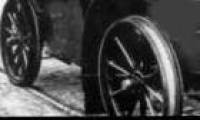
They also carried a set of wooden spoked rubber tired wheels, for the highway portion.
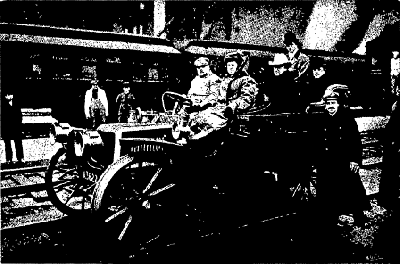
photo above from later in their trip
They completed the Canadian portion of the trip Sept 18, 1904 in Vancouver, after 3,536 miles.
Nineteen Train Orders were needed to safely pilot the Napier Limited, to Portal, 550 miles from Boston.
CPR Conductor Edgar (Ed) Hewins Cooke, received them at Portal. And directed their travel to Laggan,
736 miles, under instructions from the Train Dispatchers.
CPR Conductor, Ed Cooke, was from Moose Jaw,
born Mar 3, 1869, Louth Reg. Dist., Lincolnshire, England.
The car was considered a special train, and required an Engineer and a Conductor on board.
At that time, 25% duty was demanded by Canadian Government on Automobiles made in England.
As they were only passing through the country, on their way to Honolulu, they went under Bond to Vancouver.
Sept 9, 1904, at 8 o'clock Mountain time, Conductor Cooke, handed Charles a copy of the First Train Order ever issued in British America (Canada),
for a Motor Car to run on the Railway Tracks, which read as follows:
Canadian Pacific Railway,
Train Order #28,
Delivered at North Portal,
Automobile Extra,
Cooke Conductor,
Cooke Auto Extra will run ahead
of Second Number One Hundred and Seven,
Engine Four Forty-Six,
North Portal To Estevan,
Signed:
J. Rutherford, Dispatcher.
At Estevan they were ordered ahead to Weyburn, then to Pasqua, and finally to Moose Jaw.
For the first time they were sent ahead of the Express Train, with 20 minutes leeway, and the fastest long run, was made to Moose Jaw, 168 miles,
at an average speed of 35 miles per hour.
The express failed to overtake them, even though there were many slow downs on account of work on the road, and stops were made to allow the removal of 8 handcars.
Imagine the look of surprise on these Work gangs! They reached their highest speed of 45 mph, in the straight stretches, from Estevan to Moose Jaw.
His first choice was to follow rather than lead a fast express, as he says the tension is too great keeping out of their way.
As far as the speed of the car was concerned, he says it can be easily done.
Salutations, loud cheers and the waving of handkerchiefs, greeted them as they passed the stations.
They made it a rule to stop every 25 miles to look over the car, and this gave them the opportunity to meet the people.
As of Sept 9th, they travelled, 720 railroad miles.
They left on the 10th for Medicine Hat AB, 260 miles west.
They arrived there at 15:50 o'clock, Mountain Time.
Here is Mr. Glidden's description of the next part of the trip.
“The day's run on the tracks with Napier Motor Car to this place from Moose Jaw has been of considerable interest from a railroad standpoint.
That is we are now on the Main Line of a great transcontinental route and came in contact with an immense amount of traffic.
Regular and Extra Trains. But for the good work of the train dispatchers, an excellent rate and fast running when the word was given at the different points,
we should have fell far short of our intended destination. Not having any right-of-way it was our duty to keep clear of every train on the road.
We came up behind freight trains between stations seven miles apart and had to follow them to a siding.
Then there were delays for orders and to ascertain positions of other trains. the wind blew almost a gale over the seemingly boundless prairie,
sand from the newly made roadbed hit our faces quite hard, and to lessen the roar of the steel rimmed wheels on the tracks and rush of wind,
we placed cotton in our ears. 20 miles west of Moose jaw we passed the 19,000 miles post of the world's record to our motor car,
and drive on the tracks has now reached 1,000 miles. the country passed through today is broad prairie, ranch lands, treeless, and not yet settled.
Although a house was visible about every 20 miles. We are now working gradually toward the mountains and if schedule can be given us,
we ought to be able to reach Banff, 327 miles distant, by Sunday Night.
Not a moment's delay has been caused in the operation of the car since leaving Minneapolis,
and conductor Cooke says our speed is at times 10 miles per hour faster than the Imperial Limited, which is made with hardly a noticeable side motion.”
They stopped for 3/4 of an hour in Medicine Hat AB. morning of Sept 10th, 1904.
A very large crowd greeted the expected “Auto Special”
It took them 7 hours, for 180 miles, from Medicine Hat to Calgary.
They even had time to shoot some ducks along the way.
Arriving in Calgary, just about dark.
Reported in the Calgary papers, a stout man, medium build, wearing a big fawn coloured automobile coat, and a lady wearing a big tweed ulster, disembarked the car.
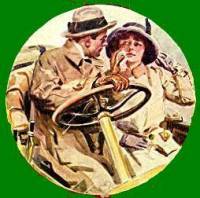
The reporter was surprised at how fast the car came into the station, and how fast it stopped.
With them at this point was their chauffer, and the CPR conductor was now a Mr. Stone from Moose Jaw.
Not sure where Conductor Cooke switched with Stone?
They spent the night of Sept 10th, at the Alberta Hotel in Calgary,and left at 10 o'clock the next day, the 11th of Sept..
Now did the chauffer do the driving? or was he the mechanic/ tire changer, for the trip?
The Alberta Hotel bar was known at that time, as the longest in Western Canada, at 125 ft.
Henry Allison Perley (1849-1933) was the Proprietor, and manager, from it's opening in Dec. 1889, to late 1904.
Located at 804 1st st. SW, in Calgary, built in 1888-1889, now renovated as Offices. Also known as the Lee Brealey Block.
One of the first Sandstone structures in the city. It had 75 rooms, at $2.50-3.00 per room/night. It was “The” Hotel in those days.
Mr. Glidden goes on later to summarize the trip:
Arrived in Vancouver at 2:00pm Pacific time.
Duration- 28 days total.
Running time, 155 hours.
Average speed, a little less than 23 MPH
Boston via Chicago to Minneapolis on the Highway.
1733 miles highway driving.
Average speed= 18 1/8 MPH.
It used one gallon of gas for every 20 miles covered.
They carried enough gas for 550 miles at a time.
By Rail, Minneapolis to Vancouver, 1803 Miles,
60 hours duration,
Avg. speed= 30 MPH.
Average on the Prairies, was 35, in the Mountains less.
Arriving in Vancouver, Mr. Charles Thomas, Engineer, and Conductor Forrest were with Mr. and Mrs. Glidden.
It was reported scores of people came to the CPR station on this Sunday afternoon, to see the car.
The car could car up to 7 people, but no more than 4 traveled in the car at one time.
Weight of car was 5,000 lbs. The wheels alone weighted 1300 lbs.
Then the best Tourist Statement possible, he makes the following comment, “In no place in the world, for the same distance, can so much beauty and grandeur be seen.”
“The road Bed and tracks are in excellent condition and our ride of the entire distance, averaging 150 miles per day, has been one of ease and comfort.
Not a moment's delay have we experienced since leaving Boston, the Napier working perfectly. The drive today of 129 miles through the Fraser Canyon,
following the course of that river, in and out of the Cascade range of Mountains, was picturesque, and gave a pleasant ending to our long journey.
Mrs. Glidden (Lucy Emma , nee Clegworth) has enjoyed the trip with the exception of the one windy day,
and is the First Lady to cross the Continent in a Motor Car.
The motor car will be equipped with its rubber tired wheels and continue its journey touring the world, commencing at Honolulu about Christmas.
Then will follow Fiji, New Zealand, Australia and the Countries of the Orient.”
In the Victoria Daily Colonist Sunday, Dec 11, 1904, page 8, it shows Charles Glidden and wife, leaving Victoria BC on Friday evening, Dec 9, 1904,
on board the Canadian-Australian liner Moana, bound for Australia
Feb 6, 1905 he sent a cable from Bluff NZ, after travelling 1145 miles in New Zealand, after 21,425 total miles total distance at that point.
Charles and Lucy Glidden of Spindle City were the first to travel around the Globe in an automobile.
Lucy died in Mar 1931, and both are buried in Lowell Cemetery, Lowell, Mass, USA
Now I don't know about you, but this guy was some brave soul, rich no doubt, but I have seen car trips on Documentaries on TV the past few years,
and they have a tough time making the trips now, never mind over a 100 years ago. Yes this was done on rail for a little over half way,
but they could have broke down, They could have had an accident, many obstacles were placed in their way, but they succeeded here,
and other trips they took before and after this. Imagine being only 20 minutes ahead of a freight train, if you suddenly broke down?
Imagine the pressure he and the conductor were under. No radios in those days. No cell phone, no nothing!
Imagine the cost of this trip!
He would have had the cost of the car, etc, plus the Conductors wages, and board for all four in the car.
No wonder he was rich to afford these trips.
He was a very famous man in the Auto circles of the era.
He pushed for many roads to be built.
And now some in Estevan can say, maybe their Grandfather seen the car go by.
Now does anyone have a picture of the car from that trip, in an old family album, and had no idea what it was about? would love to add it here if you do.
An interesting story to me, associated in a small way with Estevan. By the way, in no picture do I see a roof on this car??? Guess it didn't rain in those days.
As an interesting side story, the CPR Limited, Train #1, their main Westbound train, was held up a few miles from Mission Junction, on Saturday, Sept 10th, 1904.
by 3 armed men, each carrying 2 six shooters. Only 1 day before they went through there. It was the first CPR train robbery, and the first in Canada,
and Mr. and Mrs. Glidden were almost part of it.
Turns out it was Billy Miner, and his 2 partners in crime, Shorty Dunn and Lewis Colqohoun.
Strange and ironic part, Glidden was probably carrying more money than the train was, and a far easier target.
They would have come through the same area, and seen the search parties going over the robbery scene.
Aug 13, 2017 I received a copy of this postcard below, from Chris Morrison. His email-
“This card was written by Glidden to his book publisher. Note the exrta trips on Hawaii and Fiji. Card is in my World postal collection ”
Credit for the postcard per Chris- “Credit to my friend that found it Norm Neary. Thanks Chris Very interesting about that visit to Hawaii 30 miles.”
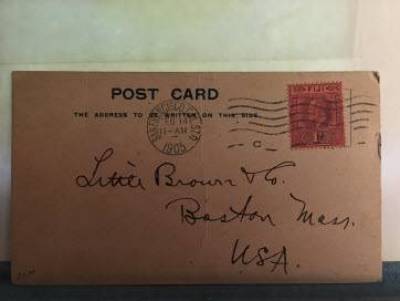
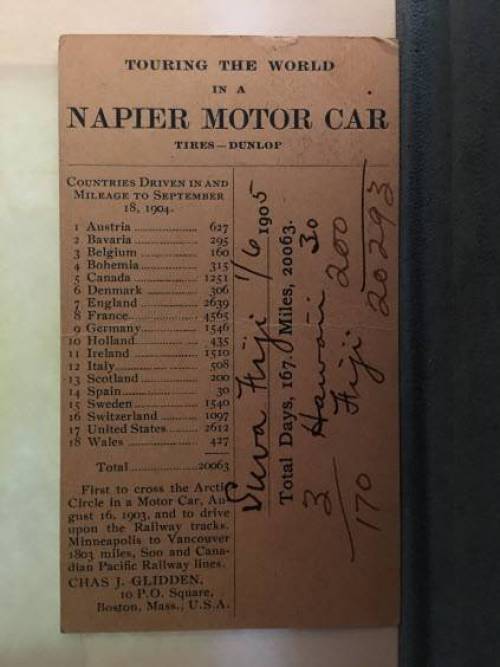
©

